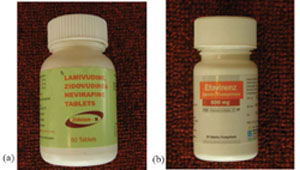22.3.3 How are antiretroviral drugs combined?
A prescribed or recommended collection of medications intended to treat a disease is called a treatment regimen (or simply a regimen). The regimens used in ART can be first line, second line, or even third line.
First-line regimens
A first-line regimen is a combination of drugs that will be given to an HIV-positive patient who has never taken any ARV drugs before. Most commonly, a first-line regimen will consist of two NsRTIs and one NNRTI.
Box 22.1 lists the most common first-line regimens used in Ethiopia at the present time (2010).
The full names of the drugs in Box 22.1 can be found from their abbreviations by looking back at Table 22.1.
Box 22.1 Common first-line drug regimens for ART
∙ AZT-3TC-NVP
∙ AZT-3TC-EFV
∙ d4T-3TC-NVP
∙ d4T-3TC-EFV
∙ TDF-3TC-EFV
∙ TDF-3TC-NVP
Note that 3TC is included in all of the first-line regimens in Box 22.1 (always listed in the middle of the three drugs). Some drugs are not used together in the same regimen. Note that d4T and AZT are not used together, and NVP and EFV are not used together.
Second- and third-line regimens
Many patients on ART will eventually develop failure of therapy, which means the first-line regimen will not be effective anymore. This is often because the drugs were not taken correctly, and this allowed HIV to become resistant to them. In that case, the doctor may decide to switch to a second-line regimen, which is more expensive. Usually, the second-line regimen will consist of two NRTIs and one PI drug in combination. The second-line regimen is stronger, but there are more pills to take, and this regimen sometimes has food restrictions and more side-effects. Even a second-line regimen can fail, if not taken consistently and correctly, so a third-line regimen may have to be used.
Note that if ART is interrupted, the virus levels in the patient’s blood will increase, and the numbers of CD4 lymphocytes will slowly decrease, until finally the health of the patient will deteriorate. Therefore, making sure that ART is continuously maintained, or in other words, that the patient maintains the adherence to the treatment, is extremely important.
First-line drug regimens and fixed-dose combinations
First-line ARVs (Box 22.1) are mainly given twice a day. But there are some drugs which are given once a day, like Efavirenz (EFV) and Tenofovir disoproxil fumarate (TDF). Note that Abacavir (ABC) and TDF can also be used as first-line ARV drugs. According to the current Ethiopian ART guidelines, new adult and adolescent patients are not started on a d4T-containing regimen; instead they are prescribed AZT or TDF-containing regimens.
First-line drug regimens commonly include ARVs in fixed dose combinations, meaning combinations of three ARV drugs in fixed doses in the same tablet (e.g. AZT + 3TC + NVP in one tablet, see Figure 22.1a); this is taken twice a day (every 12 hours) except in the first two weeks of ART. There are also fixed drug combinations which contain two drugs in one tablet (e.g. AZT + 3TC), which is given with a third drug separately (e.g. Efavirenz or EFV, see Figure 22.1 b) in a different tablet.

22.3.2 Why is the combination of three antiretroviral drugs necessary?
